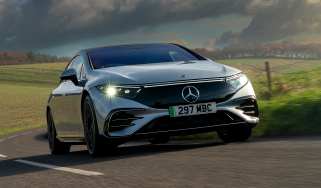Saab 9-5 2.3T Vector
The Swedes might not shout about it, but the Saab 9-5 has been a real success for the past two years. New diesels and a neat Tourer have helped boost sales of the BMW 5-Series rival to unprecedented levels. And this year, the model looks like it will score its highest number of annual registrations since its launch.
The 9-5's subtle facelift will be welcomed by Saab fans and won't upset those who have just taken delivery of the outgoing model. Deleting the V6 petrol engine might seem a strange move, but the new 2.3T unit will particularly impress company car drivers. The four-cylinder is smooth enough and offers excellent performance at a far more affordable taxation level. It will still appeal to those who want an alternative choice, but despite the changes the 9-5 looks dated against rivals such as BMW's new 5-Series.
The Swedes might not shout about it, but the Saab 9-5 has been a real success for the past two years. New diesels and a neat Tourer have helped boost sales of the BMW 5-Series rival to unprecedented levels. And this year, the model looks like it will score its highest number of annual registrations since its launch.
That's not bad for a car that's been with us since 1998. But even though it continues to do well, the 9-5 has been given a spruce-up ready for its assault on the final-quarter sales charts.
New 2004-model cars will be on sale from October, and although visual changes are limited to a different grille, modified bumpers and lower side skirts, there's much more to the latest generation than meets the eye.
Used - available now

2023 BMW
5 Series
61,961 milesAutomaticDiesel2.0L
Cash £22,800
2018 Audi
A1 Sportback
79,404 milesManualPetrol1.0L
Cash £6,995
2018 Audi
TT
22,262 milesManualPetrol1.8L
Cash £16,495
2018 Fiat
500
29,942 milesManualPetrol1.2L
Cash £7,795Aero variants get a power boost, but by far the most interesting version in the revised line-up is the 2.3T Vector. It replaces the outgoing 3.0-litre V6 model, which had 200bhp and excellent refinement, but was thirsty and belched out 263g/km of CO2, putting it in the highest company car tax bracket.
The new 2.3 four-cylinder is much cleaner. Producing 212g/km of CO2, it's nine percentage brackets lower than the 3.0 for fleet users, yet offers greater power and performance. With 220bhp, it is a development of the Aero HOT's 250bhp unit. But instead of that model's high-output turbo, the 2.3T's low-pressure boost gives smooth delivery rather than out-and-out muscle.
Yet that doesn't mean the new car is slow. The 7.5-second 0-60mph time is one second quicker than the V6's, while the 146mph top speed is identical. The only difference is in the mid-range. Whereas the V6 had a wide torque spread and linear power delivery, the new engine feels more urgent. Throttle response is sharp and the turbo quick to react, but progress is never jerky.
At cruising speeds, the motor is quiet, but lacks the V6's smoothness. Our sole complaint is that there's a fair amount of torque steer under hard acceleration, while the optional 17-inch alloys make the ride rather bumpy.
The cabin has been slightly modified, with the dash being changed from mid-grey to a more subtle, less plasticky black, while light grey leather trim is standard. The dashboard also features a new eye-level display identical to that in the 9-3, which shows warning lights and sat-nav information.
Overall, then, the 2.3T is a convincing package in the mid-size executive market and makes a lot more financial sense than its predecessor, although it lacks the V6's motorway refinement.



